Excerpts from Jim Conrad's
Naturalist Newsletter
entry from field notes dated July 2, 2022, taken on Cerro de la Cruz, at an elevation of ~2885m (~9465 ft), just south of the community of El Pinar, Amealco de Bonfil, Querétaro, MÉXICO, (~N20.17°, ~W100.17°)
GERANIUM POTENTILLIFOLIUM

In the oak forest covering Cerro de la Cruz's lower eastern slope, on the banks of a ravine where a tree-fall opened up the canopy a little, the above wild geranium presented a single, unusually large flower. The plant was recognizable as a geranium mainly by the pattern of the leaves' deep divisions -- "palmate" with three main divisions merging at their bases, and the main subdivisions themselves deeply lobed -- as well as the leaves' sparseness, small size and overall roundness. Though it's unusual for geranium flowers to be solitary, the blossom's purple color also was typical of geraniums, as was its structure:
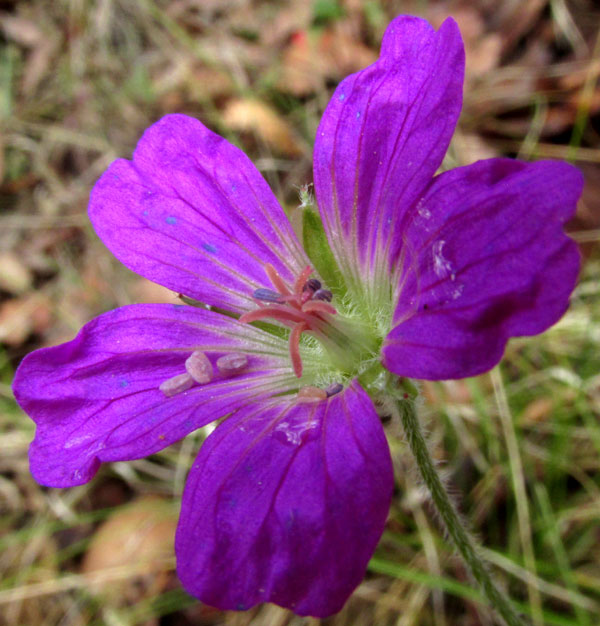
The corolla's five petals were separate from one another at their bases, and there were ten stamens, though something had removed most of the stamens' purple anthers. In the picture, dislodged anthers lie atop the petal pointing toward the left. The conspicuous, slender, curving, pinkish-purple items at the flower's center are stigmas, also typical, united at their bases into a slender style hidden by the stamens' filaments.
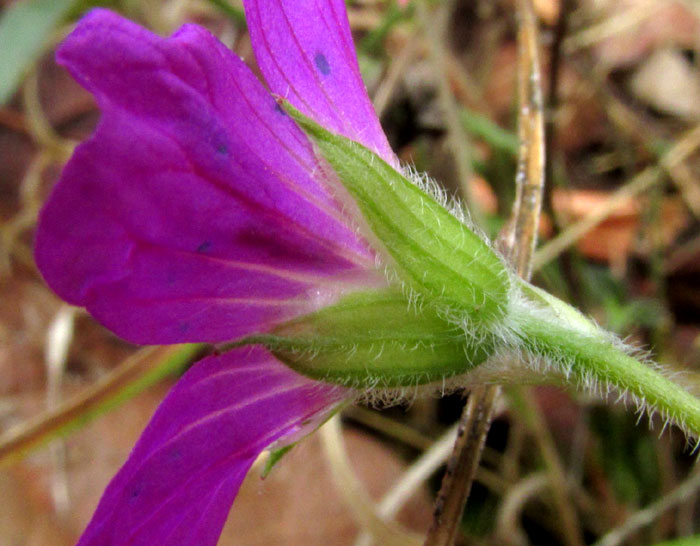
Seen from the side, the blossom's sepals were separate from one another all the way to their bases, and notably broad, long-hairy, and gradually diminishing toward the tips where a soft, slender, needle-like awn formed. On the pedicel below the flower, the long hairs tend to point downward.
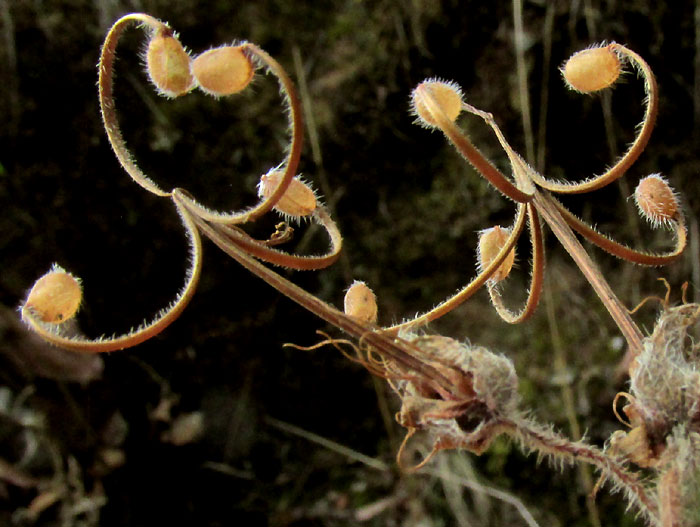
The plant, though herbaceous, was perennial, and the remains of last season's fruits, shown above, still were attached. The fruits, while remarkable in their structure, are absolutely typical of geraniums. The mature geranium fruit is so similar to a long, slender stork's bill -- sharp at the tip but gradually enlarging toward the base -- that often wild geraniums are called storkbills. Before a geranium flower releases its seeds, the base of the stork-bill center projection is surrounded by five conspicuous bulges, which are the flower's five seeds. As the fruit dries, five narrow, tough strands constituting the stork bill, each strand attached to a seed, develops within itself certain hygroscopic tensions. When the tensions reach a certain point, the strand snaps outward, catapulting the seed at its base a good distance from the plant. In the above picture, each flower's five catapults have already tossed away their seeds.
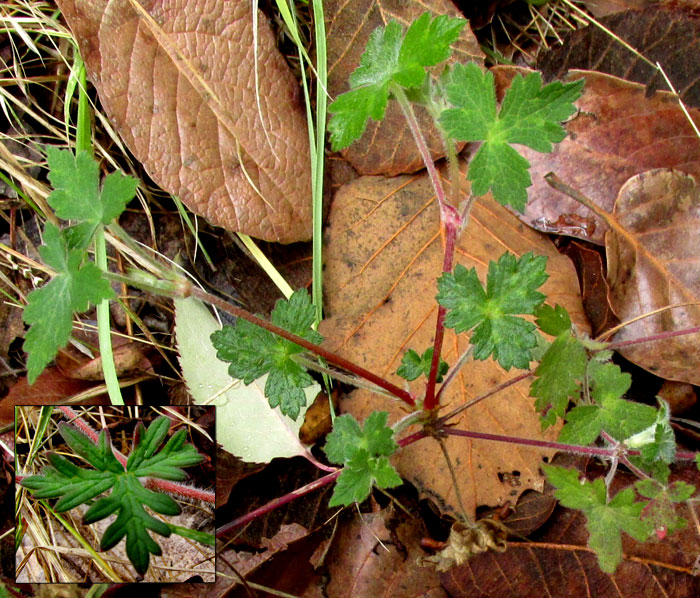
Our plant's lower leaves were less deeply divided than the stem leaves. In the above picture of the plant's lower part, an inset at the lower left shows a stem leaf for comparison.
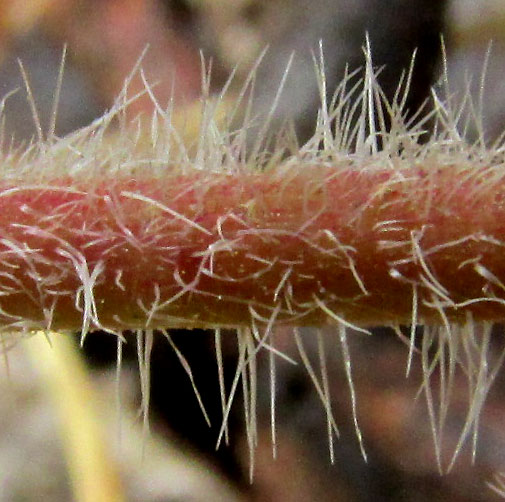
At the right, you can see that the lower stem was just as hairy as at the top, and the shorter hairs are pointing toward the base.
The Geranium Family, the Geraniaceae, comprises six genera and about 780 species. Species are distributed worldwide, mostly in coolish mountain environments. The Geranium Family's largest genus is Geranium, but Pelargonium is the second largest, and probably most potted plants people buy as geraniums are pelargoniums. Geranium species are mostly temperate annuals, while Pelargonium species are evergreen perennials mostly from warm to hot parts of the world. Pelargonium fruits also produce stork-bill-like fruits, but they don't catapult their seeds. Also, the flowers of true geraniums are radially symmetrical -- all petals about equal in size -- while pelargoniums display two upper petals different from three lower ones.
In North America north of Mexico, only three native species of the genus Geranium are recognized, though several invasive ones are common weeds. In our upland region of central Mexico known as the Bajío, about a dozen species have been documented, the native ones mostly mountainous. In this area, if you have a Geranium producing solitary flowers having petals longer than 1cm (2/5 inch), leaves and stems long hairy but the hairs bearing no glands and tending to point backwards (toward the base), and the petals are more purple than rose, you have GERANIUM POTENTILLIFOLIUM.
Geranium potentillifolium, which has no English name, is endemic just to the general area of the Trans-Mexican Volcanic Belt cutting east/west across Mexico, with Mexico City at its center. Amealco is at the northern fringe of that. Our plant occurs in oak and coniferous forests, especially in clearings such as this one's tree-fall spot, at elevations of 2250-3400m (7400-11,200 feet). It's considered uncommon over most of its distribution but sometimes abundant.
Geranium potentillifolium and the very closely related Geranium bellum traditionally have been used in this area to control hypertension. As described in Boletín Electrónico Informativo No. 131 issued by the Universidad Autónoma del Estado de Hidalgo -- Hidalgo Autonomous State University -- studies by Juan Antonio Gayosso de Lucio suggest that hypertension is controlled by these species because of their diuretic qualities; they reduce blood pressure by causing you to urinate. Their main active compound is geraniin, whose several actions on the human body are described on Wikipedia's Geraniin page.